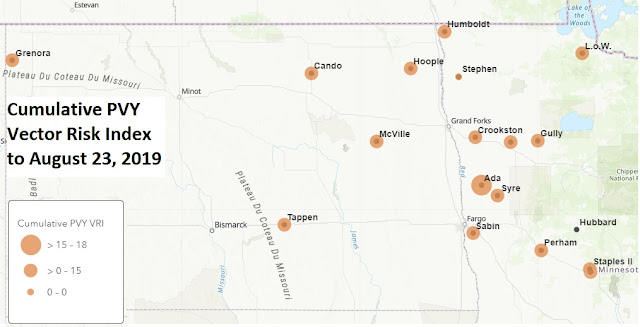Trap Catches Identified to August 23, 2019
Greetings
Aphid captures dropped this week with only 91 vectors being recovered from traps. With grain being harvested, the first flush of cereal aphids seems to be decreasing. Numbers of English Grain aphids were down across the region, but numbers of Bird-cherry Oat and Corn aphids were rising (although far less than English Grain aphids over the past 2 weeks). Green Peach aphids continue to be present in the region with two locations each capturing one of these highly effective vectors.
Ada remains the hot spot for aphid captures with 60 aphids being recovered this week, almost half of which were Corn Leaf aphids. Soybean aphids are still being captured but numbers remain low. Black bean aphid and Cotton/ Melon aphids were some of the other more common aphids recovered in traps this week.
With this week's catch, the PVY Vector Risk Index is still tracking closely to that of last year. I have heard that some growers will be initiating vine kill in the next week. Not a bad decision; the presence of green plant material means there can still be transmission of PVY. Aphid dispersal events are continuing and scouting and oil applications are again strongly recommended!
Aphid Fact of the Week - Throughout the growing season, the aphid vector species we follow reproduce asexually; there are no males, no eggs and offspring are deposited as live nymphs on plants that are appropriate food sources.
In the late summer / fall, decreasing night temperatures, daylight hours and food quality will trigger the development of a winged generation of male and female winged, reproductive aphids. These winged reproductive stages will attempt to disperse to specific plant species, often different plant species from those upon which they've feed throughout the growing season. Sexual reproduction will occur on these plants (referred to as the Primary Hosts) resulting in eggs that will overwinter on the Primary Host.
Some of the vector species of importance, including Green Peach Aphid, probably don't make it through our winters due to the lack of specific primary host plants species or adverse climatic conditions (it's not easy to make it through the Polar Vortex!)
As always, keep on scouting!
Click on any image below for full-scale version.
Cumulative PVY Vector Risk Index to August 23, 2019.
Cumulative PVY Vector Risk Index for 2018 (for comparison)
Aphid Species Capture and PVY Vector Risk Index for Aug 16-23, 2019
Cumulative Aphid Species Capture and PVY Vector Risk Index to Aug 16-23, 2019



